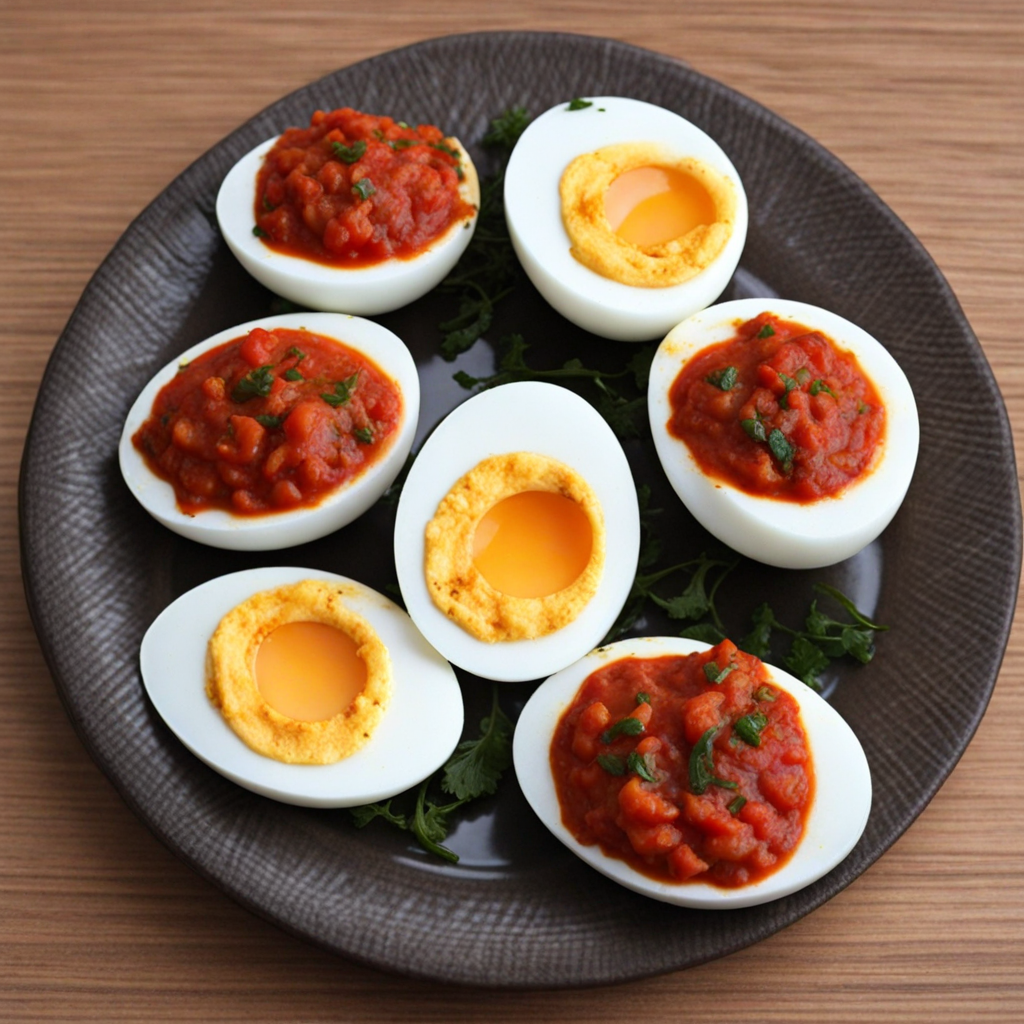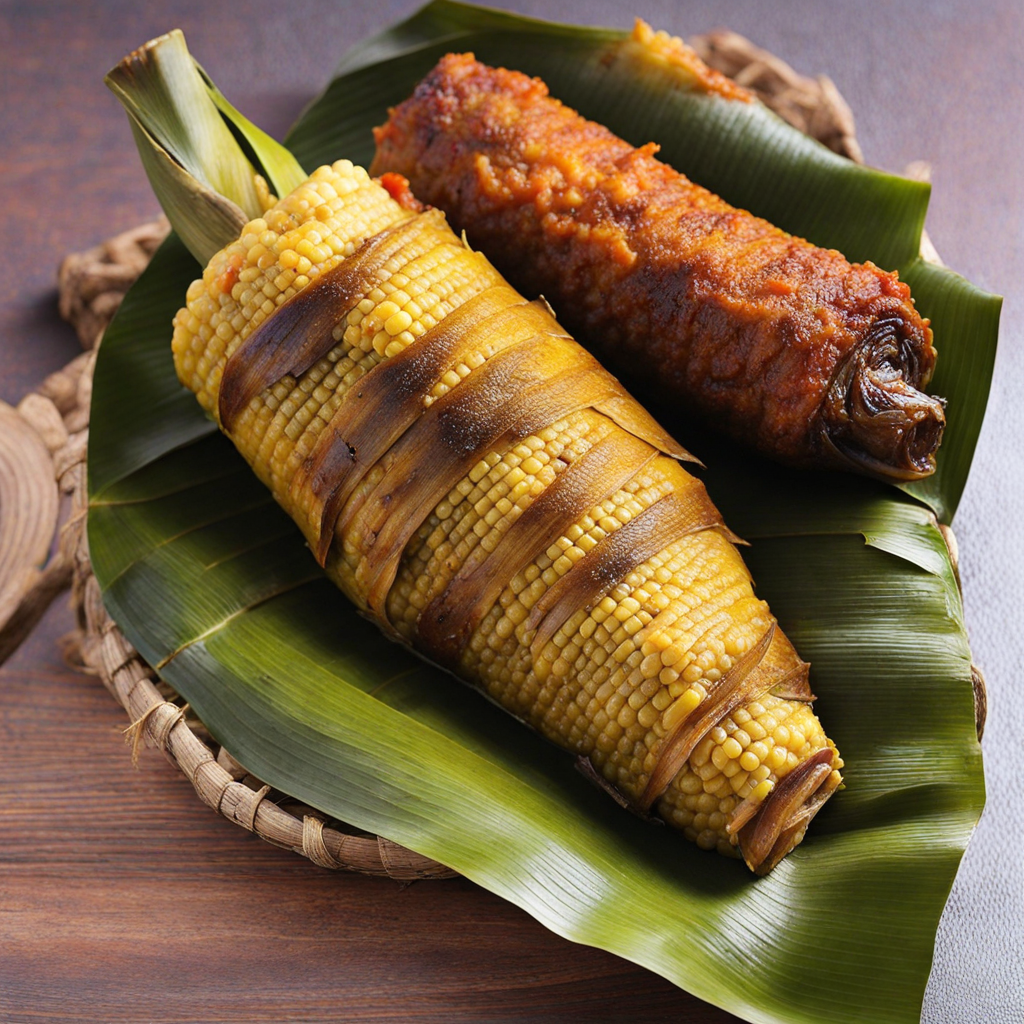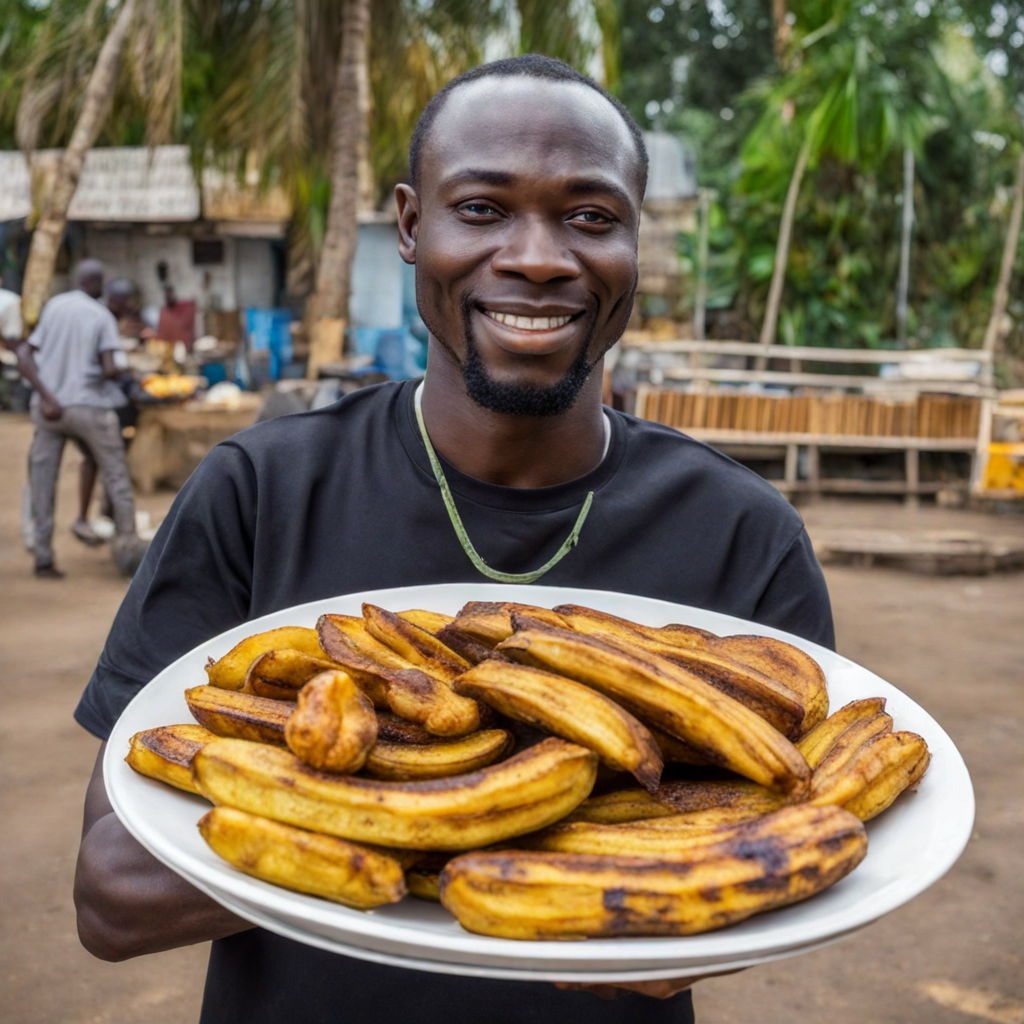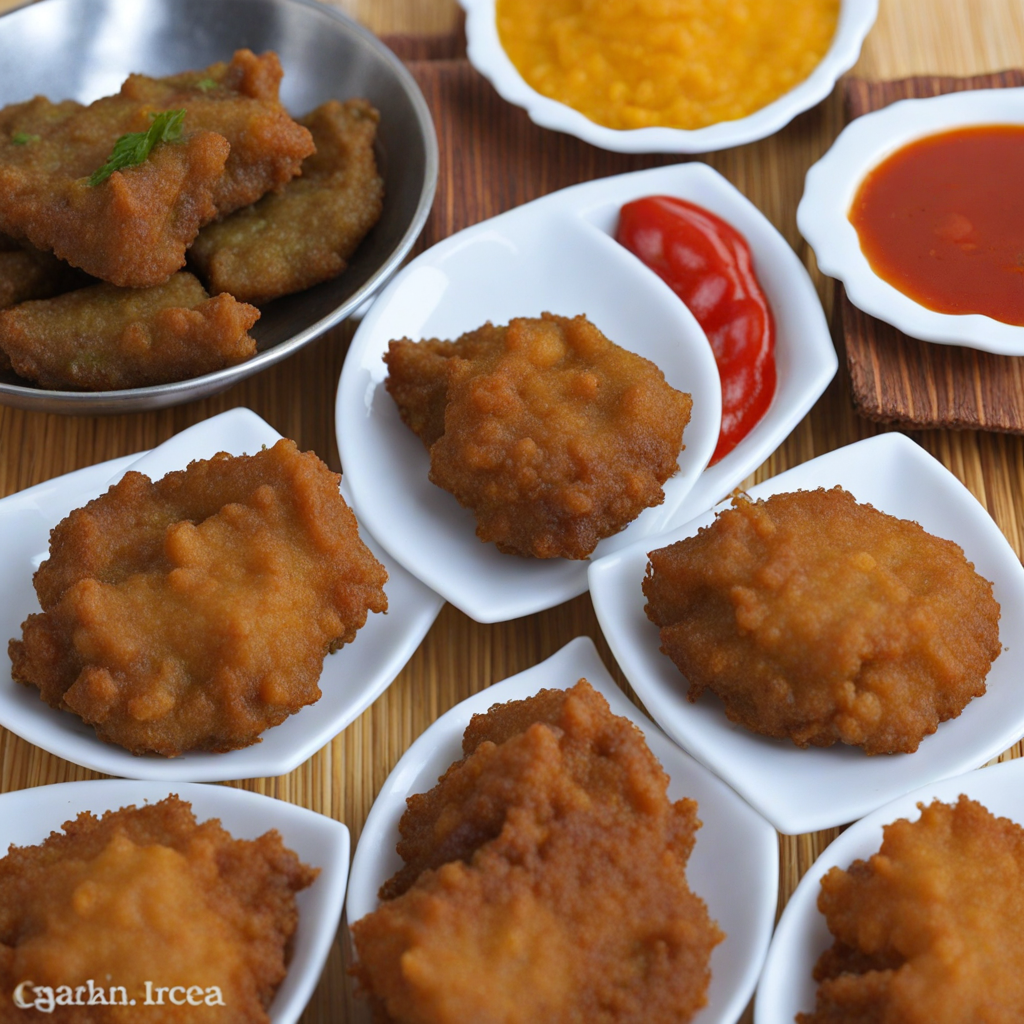Boiled Eggs with Pepper Sauce
Boiled Eggs with Pepper Sauce is a simple yet flavorful dish that showcases the vibrant culinary traditions of Ghana. The dish primarily features perfectly boiled eggs, which provide a rich and creamy texture. Each egg is cooked to a tender consistency, allowing the yolk to be just the right level of firmness, making it a satisfying base for the accompanying sauce. The eggs are often enjoyed as a snack or a light meal, providing a wholesome source of protein that complements the bold flavors of the sauce. What truly elevates this dish is the pepper sauce, a spicy and aromatic blend that reflects the essence of Ghanaian cuisine. The sauce typically consists of a mix of fresh tomatoes, onions, and a variety of peppers, including the fiery scotch bonnet. This combination creates a vibrant red sauce that bursts with flavor, offering a perfect balance of heat and sweetness. The sauce is often seasoned with spices like garlic, ginger, and a hint of salt, enhancing its complexity and making it a delightful accompaniment to the eggs. When served, the boiled eggs are usually sliced in half and generously drizzled with the pepper sauce, allowing the flavors to meld beautifully. Each bite delivers a satisfying contrast between the creamy egg and the zesty sauce, making it a truly unique taste experience. This dish not only highlights the rich flavors of Ghanaian cooking but also embodies the warmth and hospitality of the culture, inviting those who try it to savor a taste of Ghana in every mouthful.
How It Became This Dish
Kosua ne Mako: A Culinary Journey Through Ghana’s Heritage Origins of Kosua ne Mako Kosua ne Mako, a delightful Ghanaian dish, is a reflection of the rich culinary tapestry of West Africa. The name translates to "egg and beans," which succinctly encapsulates its primary ingredients. This dish finds its roots in the agricultural practices and societal norms of the Akan people, one of the major ethnic groups in Ghana. The Akan are known for their agricultural prowess, particularly in cultivating legumes like black-eyed peas and cowpeas, which are fundamental to the dish. Legumes hold a significant place in the traditional Ghanaian diet, providing essential proteins, particularly in regions where animal husbandry may not be as prevalent. The use of eggs in the dish can be traced back to the domestication of poultry, which became increasingly common as communities settled and shifted from nomadic lifestyles to more permanent agricultural settlements. Eggs, rich in protein and nutrients, were a prized addition to diets, enhancing the nutritional profile of meals like Kosua ne Mako. Cultural Significance Kosua ne Mako is more than just a meal; it is a cultural emblem that signifies community and togetherness. Traditionally, this dish is often prepared during communal gatherings, family celebrations, or festivals. The act of cooking and sharing Kosua ne Mako fosters bonds among family members and friends, highlighting the communal nature of Ghanaian culture. In many ways, sharing a meal is a form of social glue that reinforces relationships and builds community ties. In addition to its role in communal gatherings, Kosua ne Mako also holds spiritual significance. Food in Ghanaian culture is often intertwined with spiritual beliefs and practices. Meals prepared for special occasions or rituals typically reflect the values and traditions of the community. Kosua ne Mako, with its nourishing ingredients, is sometimes offered during ceremonies to bless participants and provide sustenance, symbolizing the connection between the physical and spiritual realms. Moreover, the dish is also a staple in many households, particularly among the working class, because it is affordable, filling, and easy to prepare. This accessibility has allowed Kosua ne Mako to transcend class barriers, making it a beloved choice across different social strata. Development Over Time As Ghana evolved through the centuries, so too did Kosua ne Mako. The dish has adapted to incorporate various influences, reflecting the dynamic nature of Ghanaian cuisine. The introduction of new cooking techniques, ingredients, and cultural exchanges played a pivotal role in its evolution. In the pre-colonial era, Kosua ne Mako primarily featured locally sourced ingredients. The beans were often boiled or mashed, while the eggs were either boiled or scrambled. The simplicity of the original preparation highlighted the earthy flavors of the beans, which were often seasoned with locally grown spices and herbs. The emphasis was on showcasing the natural flavors of the ingredients, adhering to the traditional culinary philosophies of the time. With the advent of colonialism in the late 19th and early 20th centuries, Ghanaian cuisine underwent significant transformations. New ingredients, such as tomatoes and peppers, were introduced by European traders and settlers. This led to a more complex flavor profile in traditional dishes, including Kosua ne Mako. The incorporation of these new ingredients not only enhanced the dish’s taste but also made it more visually appealing, with vibrant colors and textures. As Ghana gained independence in 1957, there was a resurgence of interest in traditional foods, including Kosua ne Mako. The independence movement spurred a cultural renaissance, prompting Ghanaians to take pride in their culinary heritage. Chefs and home cooks began to experiment with traditional recipes, often adding personal twists to classic dishes. This period saw the rise of street food vendors who popularized Kosua ne Mako as a quick, nutritious option for urban dwellers. In contemporary Ghana, Kosua ne Mako has found its way into various culinary spaces, from street stalls to upscale restaurants. Chefs are now blending traditional and modern cooking techniques, often presenting the dish with a gourmet twist. Variations may include the addition of vegetables such as bell peppers or avocados, and some chefs even incorporate local sauces to elevate the dish further. The rise of global awareness about Ghanaian cuisine has also contributed to the dish's popularity outside its borders. As more people become interested in African culinary traditions, Kosua ne Mako is often showcased at food festivals and cultural events worldwide. This exposure not only celebrates the dish but also serves as a platform for educating others about Ghanaian culture and history. The Modern-Day Kosua ne Mako Today, Kosua ne Mako remains a beloved dish in Ghana and among the Ghanaian diaspora. Its simplicity, nutritional value, and cultural significance make it a staple in many households. Moreover, the dish serves as a reminder of the resilience and adaptability of Ghanaian cuisine throughout history. In modern times, efforts are being made to preserve traditional recipes and cooking methods, ensuring that future generations appreciate the importance of dishes like Kosua ne Mako. Community cooking classes and culinary workshops are becoming increasingly popular, allowing people to reconnect with their heritage while enjoying the camaraderie of shared cooking experiences. Additionally, the dish has become a symbol of the push for sustainable eating practices, as beans and eggs are locally sourced and less resource-intensive compared to meat-based dishes. In a world increasingly aware of environmental issues, Kosua ne Mako stands as a testament to the benefits of traditional, plant-based diets. Conclusion Kosua ne Mako is more than just a dish; it is a narrative woven into the fabric of Ghanaian culture. From its humble origins as a nourishing meal for agricultural communities to its modern-day iterations that grace the tables of urban Ghanaians and food enthusiasts worldwide, Kosua ne Mako reflects the rich history, resilience, and creativity of the Ghanaian people. As it continues to evolve, this dish serves as a delicious reminder of the importance of community, culture, and culinary heritage in our ever-changing world.
You may like
Discover local flavors from Ghana







